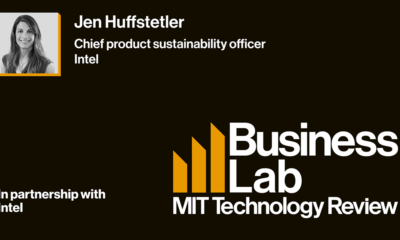Politics
Understanding Edge Computing and Why it Matters to Businesses Today
Published
1 year agoon
By
Drew Simpson
The edge computing market is expected to reach $274 billion by 2025, focusing on segments like the internet of things, public cloud services, and patents and standards.
Most of this contribution is backed by enterprises shifting their data centers to the cloud. This has enabled enterprises to move beyond cloud systems to edge computing systems and extract the maximum potential from their computing resources.
This blog will provide a closer understanding of edge computing and how it helps businesses in the technology sector.
Understanding edge computing
From a technical standpoint, edge computing is a distributed computing framework that bridges the gap between enterprise applications and data sources, including IoT devices or local edge servers.
For an easier understanding, edge computing helps businesses recreate experiences for people and profitability through improved response time and bandwidth availability.
Why does edge computing matter for businesses?
When we talk about the most significant industry zones worldwide, for instance, the GCC region, which is heavily focused on the focus areas like cloud services, the transition from cloud technology to edge computing is now more prominent than ever for enterprises to leverage the potential of the technology.
And with only 3% of businesses at an advanced stage in digital transformation initiatives, the potential of edge computing is up for grabs.
It doesn’t matter if you’re running a mobile app development company, a grocery store next door, or a next-gen enterprise. You need to understand how cloud edge helps businesses and invest in this open-source technology.
Predictive maintenance
Edge computing is primarily sought in industries where value-added assets have a massive impact on the business in case of losses.
The technology has enabled reports delivery systems to send and receive documentation in seconds, usually taking days to weeks.
Consider the example of the oil and gas industry, where some enterprises utilize edge computing. The predictive maintenance allowed them to proactively manage their pipeline and locate the underlying issues to prevent any accumulated problems.
Support for remote operations
The pandemic has forced businesses to opt for remote operations, or a hybrid work model at the least, with the workforce, spread across different geographical boundaries.
This drastic shift has brought in the use of edge apps that would permit employees to secure access to their organization’s official servers and systems.
Edge computing helps remote operations and hybrid teams by reducing the amount of data volume commuting via networks, providing computing density and adaptability, limiting data redundancy, and helping users comply with compliance and regulatory guidelines.
Faster response time
Businesses can enjoy lower latency by deploying computational processes near edge devices. For instance, employees typically experience delays when corresponding with their colleagues on another floor due to a server connected in any part of the world.
While an edge computing application would route data transfer across the office premises, lower the delays, and considerably save bandwidth at the same time.
You can quickly scale this example of in-office communication to the fact that around 50% of data created by businesses worldwide gets created outside the cloud. Putting it simply, edge computing allows instant transmission of data.
Robust data security
According to Statista, by 2025, global data production is expected to exceed 180 zettabytes. However, the data security concerns will equally increase proportionately.
And with businesses producing and relying on data more than ever, edge computing is a solid prospect to process large amounts of data sets more efficiently and securely when done near the data source.
When businesses take the cloud as their sole savior for data storage in a single centralized location, it opens up risks for hacking and phishing activities.
On the other hand, an edge-computing architecture puts an extra layer of security as it doesn’t depend on a single point of storage or application. In fact, it is distributed to different devices.
In case of a hack or phishing attempt, a single compromised component of the network can be disconnected from the rest of the network, preventing a complete shutdown.
Convenient IoT adoption
Global IoT spending is expected to surpass $410 billion by 2025. For businesses, especially in the manufacturing sector, who rely on connected technology, the internet of things is at the thickest of things in the global industry today.
Such organizations are on the constant hunt to up their computational potential and probe into IoT through a more dedicated data center.
The adoption of edge computing makes the subsequent adoption of enterprise IoT quite cheap and puts little stress on the network’s bandwidth.
Businesses with computational prowess can leverage the IoT market without adding any major infrastructure expenses.
Lower IT costs
The global IT spending on devices, enterprise software, and communication services rose from $4.21 trillion to $4.43 trillion in 2022. While a considerable share of the global spending accounts for cloud solutions, obviously as the pandemic has only pushed the remote operations and hybrid working model further up.
When users keep the data physically closer to the network’s edge, the cost of sending the data to the cloud reduces. Consequently, it encourages businesses to save on IT expenses.
Besides cutting costs, edge computing also contributes to helping businesses increase their ROI through enhanced data transmission speed and improved networks needed to experiment with new models.
How is edge computing different from cloud computing?
Although edge computing and cloud computing are each other’s counterparts for data storage and distribution, there are some key differences regarding the user’s context.
Deployment
Edge computing deploys resources at the point where data generates. In contrast, cloud computing deploys resources at global locations.
Centralization/decentralization
Edge computing operates in a decentralized fashion, while cloud computing is centralized.
Architecture
Edge is made on a stable architecture, and cloud resources are made on loose-coupled components.
Response time
Edge-based resources respond instantaneously, and cloud resources have a higher response time.
Bandwidth
Edge computing requires lower bandwidth, while the cloud counterpart consumes a higher bandwidth.
Although, the above difference makes edge computing a clear winner in all aspects for any business. But there’s a catch!
Suppose your business resides at multiple physical locations, and you need a lower latency network to promptly cater to your customers who are away from your on-prem location. In that case, edge computing is the right choice for you.
Top edge computing use cases
Although there are numerous examples of edge computing use cases, I’ll talk about a few that I find the most interesting.
Autonomous vehicles
Autonomous flocking of truck convoys is the easiest example we can come for autonomous vehicles. With the entire fleet traveling close while saving fuel expenses and limiting congestion, edge computing has the power to eliminate the needs of all the drivers except the one in the front vehicle.
The idea being the trucks will be able to communicate with the others via low latency.
Remote monitoring of oil and gas industry assets
Oil and gas accidents have proved catastrophic throughout the industry’s history. This requires extreme vigilance when monitoring the assets.
Although oil and gas assets are placed at remote locations, the edge computing technology facilitates real-time analytics with processing closer to the asset, indicating less dependency on high-quality connectivity to a centralized cloud.
Smart grid
Edge computing is on course to elevate the adoption of smart grids, enabling enterprises to handle their energy consumption better.
Modern factories, plants, and office buildings use edge platform-connected sensors and IoT devices to observe energy usage and examine their consumption in real-time.
The data from real-time analytics will aid energy management companies in creating suitable, efficient workarounds. For example, watching where high energy consumption machinery runs during off-peak hours for electricity demand.
Cloud gaming
Cloud gaming, seemingly the next-big-thing in the gaming business like Google Stadia, PlayStation Now, etc., dramatically leans on latency.
Moreover, cloud gaming companies are on the quest to build edge servers as close to gamers as possible to reduce latency and provide a fully immersive, glitch-less experience.
Final thoughts
This concludes our discussion on understanding edge computing and how it matters for enterprises worldwide.
Now that you understand the benefits of edge computing and its applications in different industries and use cases, it is evident that it’s a great value proposition for businesses that want to acquire competitive advantages and lead their spaces from the front line.
Featured Image Credit: Provided by the Author; Thank you!
Hady Shaikh
Hady Shaikh is a professional product strategist with experience of over 10 years of working with businesses in mobile app development, product marketing, and enterprise solutions spaces. His C-suite leadership and expertise spans over helping clients in the MENA and US region build top-tier digital products and acquire tech consultancy. Currently working as the Principal Product Strategist at TekRevol, a US-based custom software development company, Hady’s vision is to establish a robust digital foothold in the GCC region by helping clients with their product strategy and development.
You may like
-


The power of green computing
-


China rolls out plan to boost computing power infrastructure
-


The businesses changing climate technology
-


Why embracing complexity is the real challenge in software today
-


Top of Heart: New Book Reveals the Mindset Creating 7-Figure Businesses
-


Social Media Management: Small Businesses Can Effectively Manage Time Online
Politics
Fintech Kennek raises $12.5M seed round to digitize lending
Published
7 months agoon
10/11/2023By
Drew Simpson
London-based fintech startup Kennek has raised $12.5 million in seed funding to expand its lending operating system.
According to an Oct. 10 tech.eu report, the round was led by HV Capital and included participation from Dutch Founders Fund, AlbionVC, FFVC, Plug & Play Ventures, and Syndicate One. Kennek offers software-as-a-service tools to help non-bank lenders streamline their operations using open banking, open finance, and payments.
The platform aims to automate time-consuming manual tasks and consolidate fragmented data to simplify lending. Xavier De Pauw, founder of Kennek said:
“Until kennek, lenders had to devote countless hours to menial operational tasks and deal with jumbled and hard-coded data – which makes every other part of lending a headache. As former lenders ourselves, we lived and breathed these frustrations, and built kennek to make them a thing of the past.”
The company said the latest funding round was oversubscribed and closed quickly despite the challenging fundraising environment. The new capital will be used to expand Kennek’s engineering team and strengthen its market position in the UK while exploring expansion into other European markets. Barbod Namini, Partner at lead investor HV Capital, commented on the investment:
“Kennek has developed an ambitious and genuinely unique proposition which we think can be the foundation of the entire alternative lending space. […] It is a complicated market and a solution that brings together all information and stakeholders onto a single platform is highly compelling for both lenders & the ecosystem as a whole.”
The fintech lending space has grown rapidly in recent years, but many lenders still rely on legacy systems and manual processes that limit efficiency and scalability. Kennek aims to leverage open banking and data integration to provide lenders with a more streamlined, automated lending experience.
The seed funding will allow the London-based startup to continue developing its platform and expanding its team to meet demand from non-bank lenders looking to digitize operations. Kennek’s focus on the UK and Europe also comes amid rising adoption of open banking and open finance in the regions.
Featured Image Credit: Photo from Kennek.io; Thank you!
Radek Zielinski
Radek Zielinski is an experienced technology and financial journalist with a passion for cybersecurity and futurology.
Politics
Fortune 500’s race for generative AI breakthroughs
Published
7 months agoon
10/11/2023By
Drew Simpson
As excitement around generative AI grows, Fortune 500 companies, including Goldman Sachs, are carefully examining the possible applications of this technology. A recent survey of U.S. executives indicated that 60% believe generative AI will substantially impact their businesses in the long term. However, they anticipate a one to two-year timeframe before implementing their initial solutions. This optimism stems from the potential of generative AI to revolutionize various aspects of businesses, from enhancing customer experiences to optimizing internal processes. In the short term, companies will likely focus on pilot projects and experimentation, gradually integrating generative AI into their operations as they witness its positive influence on efficiency and profitability.
Goldman Sachs’ Cautious Approach to Implementing Generative AI
In a recent interview, Goldman Sachs CIO Marco Argenti revealed that the firm has not yet implemented any generative AI use cases. Instead, the company focuses on experimentation and setting high standards before adopting the technology. Argenti recognized the desire for outcomes in areas like developer and operational efficiency but emphasized ensuring precision before putting experimental AI use cases into production.
According to Argenti, striking the right balance between driving innovation and maintaining accuracy is crucial for successfully integrating generative AI within the firm. Goldman Sachs intends to continue exploring this emerging technology’s potential benefits and applications while diligently assessing risks to ensure it meets the company’s stringent quality standards.
One possible application for Goldman Sachs is in software development, where the company has observed a 20-40% productivity increase during its trials. The goal is for 1,000 developers to utilize generative AI tools by year’s end. However, Argenti emphasized that a well-defined expectation of return on investment is necessary before fully integrating generative AI into production.
To achieve this, the company plans to implement a systematic and strategic approach to adopting generative AI, ensuring that it complements and enhances the skills of its developers. Additionally, Goldman Sachs intends to evaluate the long-term impact of generative AI on their software development processes and the overall quality of the applications being developed.
Goldman Sachs’ approach to AI implementation goes beyond merely executing models. The firm has created a platform encompassing technical, legal, and compliance assessments to filter out improper content and keep track of all interactions. This comprehensive system ensures seamless integration of artificial intelligence in operations while adhering to regulatory standards and maintaining client confidentiality. Moreover, the platform continuously improves and adapts its algorithms, allowing Goldman Sachs to stay at the forefront of technology and offer its clients the most efficient and secure services.
Featured Image Credit: Photo by Google DeepMind; Pexels; Thank you!
Deanna Ritchie
Managing Editor at ReadWrite
Deanna is the Managing Editor at ReadWrite. Previously she worked as the Editor in Chief for Startup Grind and has over 20+ years of experience in content management and content development.
Politics
UK seizes web3 opportunity simplifying crypto regulations
Published
7 months agoon
10/10/2023By
Drew Simpson
As Web3 companies increasingly consider leaving the United States due to regulatory ambiguity, the United Kingdom must simplify its cryptocurrency regulations to attract these businesses. The conservative think tank Policy Exchange recently released a report detailing ten suggestions for improving Web3 regulation in the country. Among the recommendations are reducing liability for token holders in decentralized autonomous organizations (DAOs) and encouraging the Financial Conduct Authority (FCA) to adopt alternative Know Your Customer (KYC) methodologies, such as digital identities and blockchain analytics tools. These suggestions aim to position the UK as a hub for Web3 innovation and attract blockchain-based businesses looking for a more conducive regulatory environment.
Streamlining Cryptocurrency Regulations for Innovation
To make it easier for emerging Web3 companies to navigate existing legal frameworks and contribute to the UK’s digital economy growth, the government must streamline cryptocurrency regulations and adopt forward-looking approaches. By making the regulatory landscape clear and straightforward, the UK can create an environment that fosters innovation, growth, and competitiveness in the global fintech industry.
The Policy Exchange report also recommends not weakening self-hosted wallets or treating proof-of-stake (PoS) services as financial services. This approach aims to protect the fundamental principles of decentralization and user autonomy while strongly emphasizing security and regulatory compliance. By doing so, the UK can nurture an environment that encourages innovation and the continued growth of blockchain technology.
Despite recent strict measures by UK authorities, such as His Majesty’s Treasury and the FCA, toward the digital assets sector, the proposed changes in the Policy Exchange report strive to make the UK a more attractive location for Web3 enterprises. By adopting these suggestions, the UK can demonstrate its commitment to fostering innovation in the rapidly evolving blockchain and cryptocurrency industries while ensuring a robust and transparent regulatory environment.
The ongoing uncertainty surrounding cryptocurrency regulations in various countries has prompted Web3 companies to explore alternative jurisdictions with more precise legal frameworks. As the United States grapples with regulatory ambiguity, the United Kingdom can position itself as a hub for Web3 innovation by simplifying and streamlining its cryptocurrency regulations.
Featured Image Credit: Photo by Jonathan Borba; Pexels; Thank you!
Deanna Ritchie
Managing Editor at ReadWrite
Deanna is the Managing Editor at ReadWrite. Previously she worked as the Editor in Chief for Startup Grind and has over 20+ years of experience in content management and content development.
